Inspection, Use and Maintenance
Inspection of Ladder
Ladders need to be inspected by a qualified person for visible defects before each use. While in use, a ladder may go through conditions that may impact its integrity. A ladder with compromised integrity will not be safe for use.
General Inspection
Employees should conduct inspections for general ladder safety for all portable ladder types by checking the followings:
- Ladders should not have any damage, lack of structural integrity, missing components or loose parts
WarningDamaged or worn ladders should be destroyed.
- The steps or rungs must be tight and secure to the side rails.
- All hardware and fittings need to be properly and securely attached.
- Movable parts must be tested to see that they operate without binding or without too much free play.
- All labels should be intact and readable.
- Ladders shall be free of oil, grease, or slippery materials.
- A ladder that has been exposed to fire or strong chemicals should be discarded.
- All accessories such as leg levelers, paint shelves, stand-off shelves, etc. are in good condition.
- The ladder base shall be placed on a secure and level footing. When necessary, ladder levelers shall be used to achieve equal rail support on uneven surfaces.
- The ladder base must have the slip resistant material.
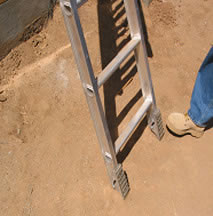
- While inspecting extensions ladders you need to make sure that:
- Ropes and pulleys are in good condition.
- Ladder extension locks move freely and lock correctly
- Rung locks are on the rails of the top section to ensure the top section will not fall.
- Extension guide brackets are secure and in place
Additional inspection
In addition to the general inspection elements mentioned above, there are ladder type specific elements that also need to be inspected. Do not use the ladder if you find any of the ladder-specific conditions listed below present in the type of ladder you are inspecting.
- For metal ladders, also check for the followings:
- loose rungs, nails, bolts screws and other metal parts
- dented rungs or rails
- sharp edges, corners and burrs
- damage from corrosion
- bends and breaks
- tags or stickers reading "CAUTION-Do Not Use Around Electrical Equipment" or similar wording.
- For wooden ladders also inspect the followings:
- integrity of rungs and rails
- chips, splits, cracks and splinters in the rails
- holes and knots
- loose / wiggly parts
- painted wooden parts (transparent paint is OK)
- Fiberglass or plastic ladders should be inspected for the following elements as well:
- cracks, chips and splinters
- deformed rails or rungs from heat, chemical or environmental exposure
- bends and breaks
- For self supporting step ladders, also inspect for the following:
- the two front legs should be of the same length and the two hind legs should also be of the same length
- spreaders are intact and lock correctly
Use of Ladder
Position Ladders Correctly
-
Keep the area around the top and bottom of a ladder clear.
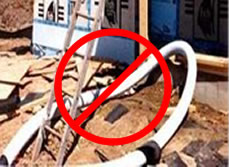
- When using a ladder in a crowded area, erect warning signs or barricades to guide traffic away from the foot of the ladder. If this is not possible, have someone hold and guard the bottom of the ladder.
- Rest the base of ladder on a spot away from hallways, passageways, doorways, driveways or heavy traffic areas. Never set up a ladder in front of a door unless the door is locked or a guard is posted.
-
Rest the base of ladders on firm, level, dry, non slippery surfaces. If one foot sits in a low spot, build up the surface with firm material or use leg levelers or mudsills when necessary to provide firm support.
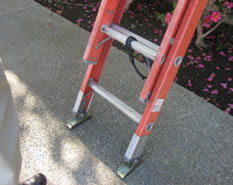
- Make sure the ladder is sitting straight and secure before climbing it. Do not allow ladders to lean sideways. Level them before using.
- Position the extension ladder such that top section is above and resting on the bottom section with the rung locks engaged.
-
To provide the correct angle so extension ladders won’t slip, place the base of the ladder one foot away from whatever the top of the ladder leans against, for every four feet in height of the ladder.
To check, put your feet at the base of the ladder and extend your arm straight out. If you can touch the closest part of the ladder without bending your arm, or bending over, the ladder is at the correct angle. If not, the ladder is not at a safe angle.
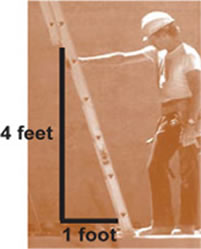
- Do not try to make a ladder reach farther by setting it on boxes, barrels, bricks, blocks or other unstable bases.
- Never set up or use a ladder in a high wind, especially a lightweight metal or fiberglass type. Wait until the air is calm enough to insure safety.
- Do not use ladders on ice or snow unless absolutely necessary. If they must be used on ice or snow, use spike or spur-type safety shoes on the ladder feet and be sure they are gripping properly before climbing.
-
When two or more separate ladders are used to reach an elevated work area, make sure that the ladders are offset with a platform or landing between the ladders.
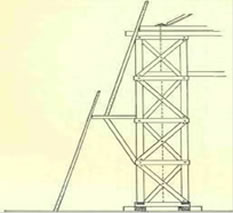
-
Remember that the side rails shall extend 36 inches or more above the upper landing surface. When such an extension is not possible, then the ladder shall be secured at its top to a rigid support that will not deflect, and a grasping device, such as a grab-rail must be provided to assist employees in mounting and dismounting the ladder.
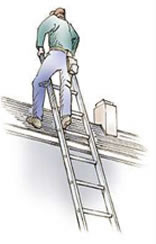
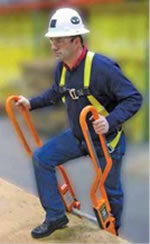
Secure Ladders Properly
- The ladder shall be so placed as to prevent slipping, or it shall be tied, blocked, held, or otherwise secured to prevent slipping. One way to prevent slipping is to use safety shoes on ladder feet.
- Brace the foot of the ladder with stakes or place stout boards against the feet if there is any danger of slipping.
- Tie, block or otherwise secure the ladder to prevent it from being displaced.
-
Make sure that the top support is supported equally on the two rails, unless a single support attachment is provided and used.
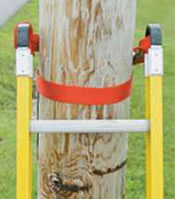
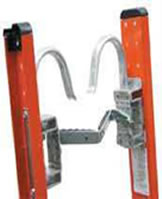
- Top support for a ladder is as important as good footing. The top should rest evenly against a flat, firm surface. If a ladder is to be leaned against a surface, test the surface first for strength and stability.
Maintain Overlap in Extension Ladders
While using extension ladders, make sure that you are always maintaining at least the minimum required overlap between the sections of the ladder. The minimum overlap lengths are:
| Ladder Size (Feet) | Minimum Overlap (Inches) |
|---|---|
| Up to and including 32 | 36 |
| Over 32, up to and including 36 | 46 |
| Over 36, up to and including 48 | 58 |
| Over 48, up to and including 60 | 70 |
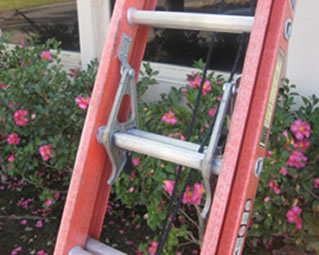
Do Not Overload the Ladder
While using portable ladders, you also need to make sure that you are not overloading the ladder. The maximum working loads for different types of ladders are:
| Duty Rating | Ladder Type | Working Load (Pounds) |
|---|---|---|
| Special Duty | IAA | 375 |
| Extra Heavy-Duty | IA | 300 |
| Heavy-Duty | I | 250 |
| Medium-Duty | II | 225 |
| Light-Duty | III | 200 |
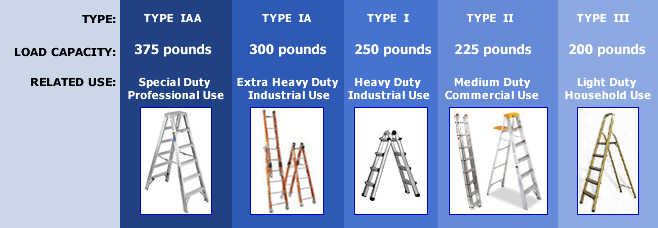
Climb and Work Safely on Ladders
-
While climbing and working on ladders, you need to climb or work with the body near the middle of the step or rung to keep the load on the ladder centered.
Make sure that you do not overreach from the center position. To avoid overreaching, you need to descend and reposition the ladder.
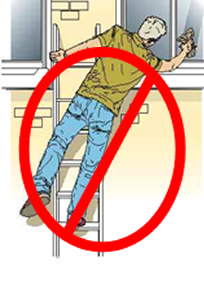
- When it is not practical to work with the body near the middle of the step or rung, you need to secure the ladder at the top, and use a personal fall protection system.
-
Always face the ladder and maintain contact with the ladder at three-points at all times. Contact with the ladder at three points means two feet and one hand, or two hands and one foot which is safely supporting the user's weight.

- Do not carry equipment or materials on ladders. Have coworkers hand up tools and equipment instead of carrying them when on a ladder.
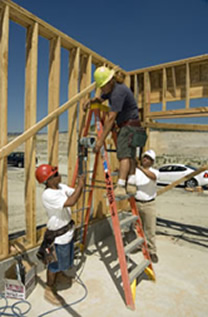
- Make sure that you are not standing and working on the top 3 rungs of a single or extension ladder. If you have to work from the top 3 rungs, ensure that there are structures that provide you with a firm handhold or you use a personal fall protection system.
- Do not stand on the topcap or the step below the topcap of a step ladder.
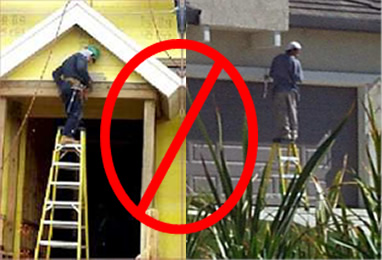
- Do not use cross-bracing on the rear section of step ladders for climbing.
- Ladders shall not be moved, shifted, or extended while in use, unless permitted by the manufacturer.
- Always follow manufacturer's recommendations for proper use.
Follow Safe Work Practices
Following safe work practices like these given below can save your employees from the accidents and injuries while climbing and using ladders in workplace.
- Get help when needed. DO NOT try to do alone if you can't do it safely by yourself.
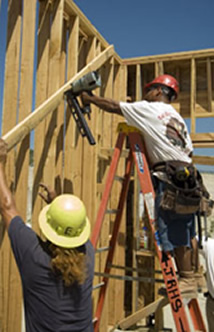
- DO NOT take short cuts.
- Use ladder only for the purpose it is made for.
- Read and follow all labels/markings on the ladder.
- Never use a ladder when under the influence of alcohol, on drugs or medication, or in ill health.
- If you get sick, dizzy or panicky while on a ladder, do not try to climb down in a hurry. Wait. Drape your arms around the rungs and rest your head against the ladder until you feel better. Then climb down slowly and carefully.
- Allow only one person at a time on a ladder unless the ladder is specifically designed to hold more than one person at a time (e.g., double sided or mechanics ladders).
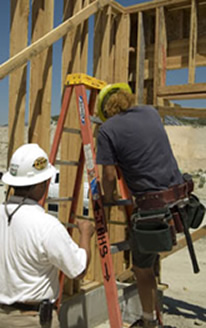
- Never use a ladder on a scaffold platform. If you need to reach higher, the scaffold should be higher.
- DO NOT use step ladders as single ladders or in a partially closed position.
- Be sure that all locks on an extension ladder are properly engaged.
- Always open a stepladder completely and make sure the spreader is locked open before using the ladder.
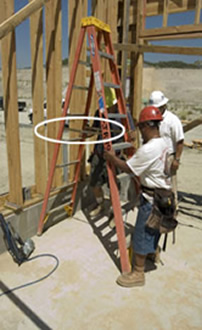
- Never slide down a ladder.
- Never climb onto a ladder from the side, from above the top or from one ladder to another.
- Do not straddle the front and back of a stepladder.
- Ladders shall not be used in a horizontal position as platforms, runways, or scaffolds unless designed for such use.
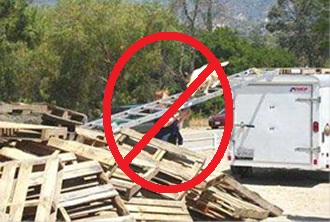
- DO NOT use ladders as a brace, skid, guy or gin pole, gangway, or for uses other than they were intended.
- DO NOT use wooden ladders that are painted.
- Never tie or fasten ladders together to gain additional length/height.
- Avoid overhead electrical hazards. Look for overhead power lines before handling a ladder. Avoid using a metal ladder near power lines.
- Never use metal ladders around exposed electrical wiring. Metal ladders should be marked with tags or stickers reading "CAUTION-Do Not Use Around Electrical Equipment" or similar wording.
- Use only the non-conductive ladders in wet and damp locations where electrical work is anticipated.
- Wear shoes with slip resistant soles.
- Clean mud and other slippery substances off your shoes and ladder rungs before climbing the ladder.
- When moving an extension ladder always retract the “fly” section(s).
- When carrying an extension ladder keep the bottom section lower than the top. Use a ladder dolly to help you carry heavy ladders.
- When using extension ladders consider using fall protection systems
Maintenance of Ladder
- Keep all ladders and ladder accessories, especially safety shoes, maintained in good condition at all times.
- Withdraw damaged ladders immediately from service for repair or destruction.
- Treat all wood ladders, which are to be used outside, to protect from weather damage. A clear finish or transparent penetrating preservative should be used. Never paint a wood ladder.
- Never store materials on a ladder.
- Store wood ladders where they will not be exposed to excessive heat or dampness. Store fiberglass ladders where they will not be exposed to sunlight or other ultraviolet light sources.
- Be sure that ladders are properly supported and secured when in transit. Vibration and bumping against other objects can damage them.
- Store ladders on racks, which give them proper support when not in use.
- Metal bearings of extension ladder rung locks and pulleys should be lubricated periodically, and between regular maintenance periods whenever necessary.
- Ropes on extension ladders should be in good condition. If they become frayed or badly worn, replace them.
- DO NOT use ladders with broken or missing steps, rungs, cleats, safety feet, side rails, or other defects.
- Keep the ladders free of oil, grease, or slippery materials all the time by cleaning frequently.
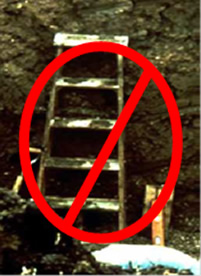
- Store all ladders to protect them from weathering effects.
Prohibited Uses
Listed below are the most common prohibited uses
- Use of damaged or defective ladders
- Use of ladders inappropriate for the specific job
- Hand carry loads or equipment while on a ladder
- Reach to the point where you lose your balance
- Stand or work on the top cap or the step below the top cap of a stepladder
- Stand or work on the top 3 rungs of an extension ladder
- Place ladders on boxes, barrels, pick- up trucks or scaffolds or equipment
- Use portable ladders in a horizontal position as a plank, platform, or scaffold etc.
- Splice together short ladders to make longer ladders
- Use ladders with only a single rail
- Use ladders in high winds
- Use extension ladders without maintaining minimum overlap
- Using ladder that does not meet the required duty rating
- Replace all frayed or badly worn ropes


